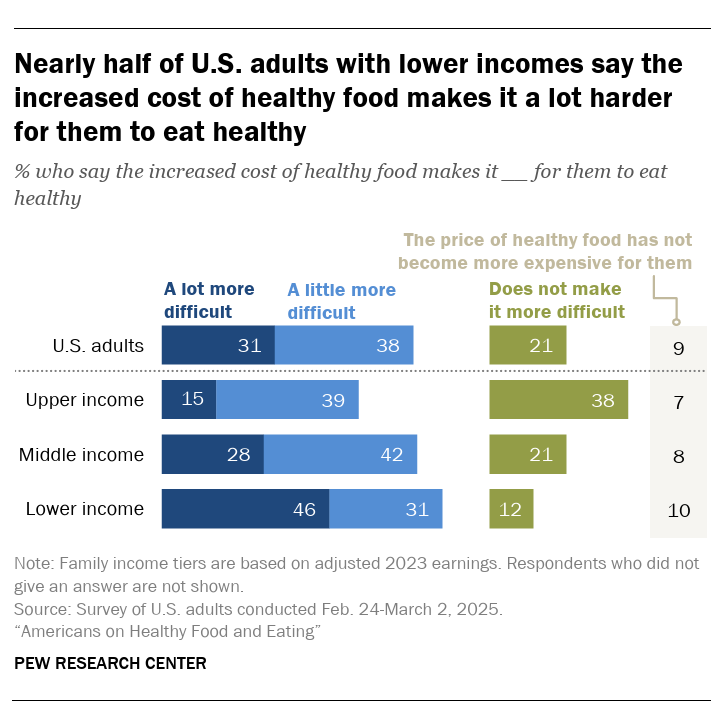HealthPopuli.com – Read More
Most people in the U.S. say it’s harder to eat healthy given the cost of “healthy food,” we learn in the report on Americans on Healthy Food and Eating from the Pew Research Center, published 7 May 2025. With a view that healthy food is “too expensive,” it may feel like aspiring for it feels like luxury-good shopping, or being a patient prescribed a specialty (high-cost) drug.

The Pew team polled 5,123 U.S. adults’ perspectives on eating, fielded between 24 February and 2 March 2025.
This report is timely as Secretary of Health and Human Services Robert F. Kennedy, Jr., launches his “MAHA” strategy, to Make Americans Healthy Again. A key pillar of that public health mission is to improve Americans’ food and nutrition habits.
The Pew data reveals that while the “healthiness of food is important,” taste and cost matter more. 
Above cost, most U.S. adults say it’s the taste above all that influences them to decide what food to buy — for 83%. Then 62% of people, roughly 2 in 3, say it’s cost that is the next most important factor in deciding what food to get.
“How healthy food is” is important to roughly one-half of U.S. consumers, and convenience ranks a close fourth for nearly one-half as well.
More granularly, the cost of healthy food makes it “a lot more difficulty” for 31% of U.S. consumers to eat healthy. Another 38% of people say the increased cost of healthy food makes it (a little more difficult” to eat healthy.
The price of healthy food does not make a difference among 30% of U.S. consumers in terms of making it harder to eat healthy. 
The price of healthy food is a larger burden on people earning lower incomes than higher, by a factor of 3:1 in terms of the food being “a lot more difficult” to afford: that is, 46% of folks with lower incomes say it’s a lot more difficult to eat healthy due to food costs compared with 15% of people in the upper income category.
By other demographic differences, it is easier for White and Asian people to find healthy food close to them compared with Black and Hispanic people.
And in terms of community type, somewhat fewer people in rural America say it’s easy to find healthy food close to them compared with people in suburban and urban U.S. geographies.
Finally, in terms of education attainment, more Americans with a postgrad or college grad education are confident they know which foods are healthy for them — 60% and 55%, respectively — versus 47% of Americans with some college and 42% with high school or less.

Health Populi’s Hot Points: The Reader’s Digest magazine published this helpful shorthand diagram of the ten foods that will likely cost more due to tariffs; I note many of these are on the healthy eating styles of the DASH and Mediterranean diet that I try to adhere to, and in my household we’re coveting well-priced avocadoes when we can find them and our often go-to salmon, along with regularly roasting peppers and savoring tomatoes — noting higher prices in our suburban Philadelphia grocery shopping landscape.
“Tariffs are driving food prices up,” a Food & Wine magazine look into President Trump’s tariff plans on consumer grocery impacts could be. These would especially negatively impact shoppers’ costs for fresh produce, which could increase over 5%.
In Food & Wine’s words, “Households could lose thousands: Without changes in shopping habits, the average household may lose up to $4,900 in 2025 due to trade-driven price hikes, though adjustments like buying in bulk or switching brands could reduce that to about $2,600,” the story calculates. No surprise, then, that lower-income households would be hardest-hit, where these families already spend a larger proportion of their income on food with less flexibility in home budgets to spend more on fresh food.
The data came out of an analysis from the Yale Budget Lab assessing tariffs’ impacts on various spending categories, both industrial and consumer-facing.

I put together this two bar slide comparing the cost of healthy eating via a MyPlate strategy — running between $1,000 and $1,200 a month for a family of 4 — compared with the average cost of a course of GLP-1 medicines for weight loss running about $12,000 plus-or-minus depending one’s health plan, according to GoodRx’s analysis from May 2025.
Here was my introductory thought on healthy eating as a luxury good, or akin to a specialty medicine….in the context of what the MAHA movement may be thinking about food, health access, health education, and other social drivers of health beyond healthcare — but certainly including access to health care (say, via Medicaid especially in lower-income household families).
The great irony has to do with Secretary Kennedy’s “MAHA” promise to “Make Americans Healthy Again.” With the tariff era now part of American policy reality, the findings from the Pew data where costs play a large role in peoples’ healthy eating choices could militate against health consumers’ ability to pay for fresh, nutritious food.
Check out this video from NBC News for more details on this report from Yale Budget Lab.
The post If Food Is Medicine, Some Might Feel It’s a Luxury Good Like a Specialty Drug appeared first on HealthPopuli.com.





